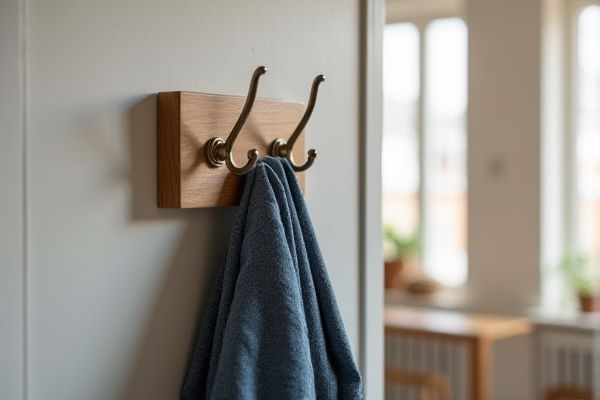
A coat hook is designed primarily for hanging outerwear like jackets and hats, while a valet hook offers added functionality, often including a bar or shelf to hold accessories like ties or belts. Discover how understanding these differences can improve your organization by reading the rest of the article.
Table of Comparison
| Feature | Coat Hook | Valet Hook |
|---|---|---|
| Primary Use | Hanging coats, jackets, hats | Organizing suits, ties, and accessories |
| Design | Simple, single or double hooks | Multi-functional with multiple hooks and bars |
| Location | Entryways, closets, walls | Bedrooms, dressing rooms, closets |
| Material | Metal, wood, plastic | Wood, metal, often with polished finish |
| Functionality | Holds outerwear securely | Keeps clothes wrinkle-free and organized |
| Price Range | Low to mid | Mid to high |
Understanding Coat Hooks: Definition and Purpose
Coat hooks are wall-mounted fixtures designed to hang outerwear, hats, or bags, providing convenient and space-saving storage. Unlike valet hooks, which often include additional features for organizing accessories such as ties or belts, coat hooks primarily serve the purpose of quickly hanging garments. Their simple design allows for easy access and efficient use of entryway or closet space.
What Is a Valet Hook? Key Features Explained
A valet hook is a specialized hanging device designed to organize clothing, often featuring multiple hooks or bars to hold coats, ties, belts, and accessories in one convenient place. Key features include its compact design for saving space, sturdy construction to support heavier garments, and versatility in placement, such as walls or doors. Unlike standard coat hooks that primarily hold outerwear, valet hooks provide a more organized and accessible solution for daily outfit preparation.
Design Differences Between Coat Hooks and Valet Hooks
Coat hooks are typically designed with multiple prongs or pegs to hold various items like jackets, hats, and scarves, emphasizing practicality and space efficiency. Valet hooks often feature a sleeker, more refined design with a single or fewer hooks, intended to organize your suit jacket, trousers, and accessories neatly. The material and finish of valet hooks usually convey a more sophisticated aesthetic compared to the utilitarian style of traditional coat hooks.
Installation Methods: Coat Hook vs Valet Hook
Coat hooks are typically installed using screws or adhesive backings on walls or doors, providing quick and sturdy mounting for everyday use. Valet hooks often require more precise installation, frequently mounted on wardrobe interiors or closets with screws or brackets to support heavier garments and accessories. Both types benefit from secure anchoring into studs or solid surfaces to ensure durability and optimal load-bearing capacity.
Space Utilization: Which Hook Suits Your Room?
Coat hooks offer compact, vertical storage ideal for maximizing wall space in small rooms or entryways, while valet hooks provide multifunctional use by combining hanging space with additional compartments for accessories, making them suitable for organized bedrooms or dressing areas. Choosing between a coat hook and a valet hook depends on available room space and storage needs; coat hooks efficiently handle outerwear withoutZhan Yong floor or surface area, whereas valet hooks optimize space by consolidating garments and personal items in one spot. For narrow or limited spaces, wall-mounted coat hooks deliver practical storage, whereas valet hooks enhance space utilization in more spacious rooms needing combined wardrobe and accessory management.
Weight Capacity: Sturdiness Comparison
Coat hooks typically offer a moderate weight capacity, generally supporting around 10-20 pounds, suitable for hanging coats, hats, and light bags. Valet hooks feature a sturdier construction designed to hold heavier items such as suits or multiple garments, often supporting up to 30 pounds or more. The difference in material strength and mounting style makes valet hooks more reliable for weight-bearing needs compared to standard coat hooks.
Material and Finish Options for Each Hook Type
Coat hooks are commonly crafted from materials like brass, stainless steel, and wood, offering finishes such as chrome, matte black, and polished nickel to blend seamlessly with various interior styles. Valet hooks often feature sturdy metals like brushed steel or aluminum with finishes designed to minimize wear and provide a sleek, modern look ideal for organizing suits and garments. Selecting the right material and finish ensures your hooks provide durability and complement your room's aesthetic.
Aesthetic Appeal: Choosing the Right Look
Coat hooks often feature minimalist designs that blend seamlessly with modern interiors, while valet hooks offer a more sophisticated and polished appearance ideal for upscale or traditional settings. The choice depends on the desired aesthetic impact, with coat hooks providing functional simplicity and valet hooks adding an element of refined organization. Selecting the right hook enhances room decor by complementing existing styles and elevating overall visual appeal.
Ideal Uses: When to Choose Coat Hooks vs Valet Hooks
Coat hooks are ideal for everyday use, perfect for hanging heavy outerwear like jackets, coats, and scarves in entryways or closets. Valet hooks serve best in bedrooms or dressing areas, designed to hold suits, ties, or outfits for the next day, keeping your clothes wrinkle-free and organized. Choose a coat hook for quick-access outerwear storage, while a valet hook is suited for planned outfit preparation and delicate garments.
Maintenance and Longevity of Coat and Valet Hooks
Coat hooks and valet hooks differ in maintenance, with coat hooks generally requiring less frequent cleaning due to their simple design and sturdy materials like metal or wood. Valet hooks, often integrated into furniture or equipped with additional features like trays and compartments, may need more careful upkeep to prevent wear and maintain functionality. You can extend the longevity of both by regularly cleaning surfaces and ensuring screws or attachments remain tight and rust-free.
 homyna.com
homyna.com